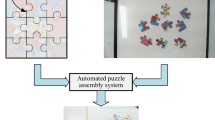Abstract
The potential of applying image processing tools and artificial intelligence in learning processes is identified. This article presents the development of a digital tutor that helps solve a puzzle. Point cloud technology is used to identify each person’s interaction dynamically in space. The proposed methodology is developed in several stages. The first stage consists of the acquisition and pre-processing system for adquaring the user environment. The second stage consists of recognizing the piece in the puzzle, at this stage it is necessary to develop a database of the particular puzzle. In the identification process, the PCA algorithm is implemented as a complementary strategy to the use of the neural network. The last stage implements a general search algorithm as the core of the decision system. This methodology is presented as an iterative process and evolves over time according to the interaction with the user. The results are presented through confusion matrix which exhibits a performance of 92.7% assertiveness. Finally, the potential of using this methodological structure in different cognitive processes with puzzles with different levels of difficulty is raised.
Access this chapter
Tax calculation will be finalised at checkout
Purchases are for personal use only
Similar content being viewed by others
Notes
- 1.
The entire puzzle database is available at: https://www.dropbox.com/sh/yirqf4xv7lrs13j/AACMKJb0QaklhsItmjXKD88oa?dl=0.
References
Bloom, B.S.: The 2 sigma problem: the search for methods of group instruction as effective as one-to-one tutoring. Educ. Res. 13(6), 4–16 (1984). https://doi.org/10.3102/0013189X013006004
Gao, Y., Barendregt, W., Obaid, M., Castellano, G.: When robot personalisation does not help: insights from a robot-supported learning study. In: RO-MAN 2018–27th IEEE International Symposium on Robot and Human Interactive Communication, pp. 705–712 (2018). https://doi.org/10.1109/ROMAN.2018.8525832
Essa, A., Laster, S.: Bloom’s 2 sigma problem and data-driven approaches for improving student success. In: The First Year of College: Research, Theory, and Practice on Improving the Student Experience and Increasing Retention, pp. 212–246. Cambridge University Press (2017). https://doi.org/10.1017/9781316811764.009
Zaga, C., Zaga, C., Lohse, M., Truong, K.P., Evers, V.: The effect of a robot’s social character on children’s task engagement: peer versus tutor. In: Lecture Notes in Computer Science (Including Subseries Lecture Notes in Artificial Intelligence and Lecture Notes in Bioinformatics), 9388 LNCS, pp. 704–713 (2015). https://doi.org/10.1007/978-3-319-25554-5_70
Kolomaznik, M., Sullivan, M., Vyvyan, K.: Can virtual reality engage students with teamwork. Int. J. Innov. Sci. Math. Educ. 25(4), 32–44 (2017)
Nourbakhsh, I.R., Sycara, K., Koes, M., Yong, M., Lewis, M., Burion, S.: Human-robot teaming for search and Rescue. In: IEEE Pervasive Computing, vol. 4, no. 1, pp. 72–77 (2005). https://doi.org/10.1109/MPRV.2005.13
Murphy, R.R.: Human-robot interaction in rescue robotics. IEEE Trans. Syst. Man Cybern. Part C: Appl. Rev. 34(2), 138–153 (2004). https://doi.org/10.1109/TSMCC.2004.826267
Levitt, T.S., Lawton, D.T.: Qualitative navigation for mobile robots. Artif. Intell. 44(3), 305–360 (1990). https://doi.org/10.1016/0004-3702(90)90027-W
Shaik, K.B., Ganesan, P., Kalist, V., Sathish, B.S., Jenitha, J.M.M.: Comparative study of skin color detection and segmentation in HSV and YCbCr color space. Procedia Comput. Sci. 57, 41–48 (2015). https://doi.org/10.1016/j.procs.2015.07.362
Norvig, P., Russell, S.: Artificial Intelligence: A Modern Approach, 4th edn., pp. 76–84. Pearson, Hoboken (2003)
Rusu, R.B., Cousins, S.: 3D is here: point Cloud Library (PCL). In: Proceedings - IEEE International Conference on Robotics and Automation (2011). https://doi.org/10.1109/ICRA.2011.5980567
Khoshelham, K., Elberink, S.O.: Accuracy and resolution of kinect depth data for indoor mapping applications. Sensors 12(2), 1437–1454 (2012)
Sung, J., Ponce, C., Selman, B., Saxena, A.: Unstructured human activity detection from RGBD images. In: Proceedings - IEEE International Conference on Robotics and Automation, pp. 842–849 (2012). https://doi.org/10.1109/ICRA.2012.6224591
Welk, A., et al.: Computer-assisted learning and simulation lab with 40 DentSim units. Int. J. Comput. Dentistry, 11(1), 17–40. (2008). ISSN: 14634201 2–s2.0-49049085467
Zheng, J., Cao, X., Lin, Y., Zhang, J., Feng, X.: An introduction of DentSim in pre-clinical dental training and practice. Shanghai kou qiang yi xue - Shanghai J. Stomatol. 23(6), 749–754 (2014)
Fletcher, J.D.: The value of digital tutoring and accelerated expertise for military veterans. Educ. Technol. Res. Dev. 65(3), 679–698 (2017). https://doi.org/10.1007/s11423-016-9504-z
Woods, K.: The development and design of an interactive digital training resource for personal tutors. Front. Educ. 5, 100 (2020) https://doi.org/10.3389/feduc.2020.00100
Suebnukarn, S., Haddawy, P.: A collaborative intelligent tutoring system for medical problem-based learning. International Conference on Intelligent User Interfaces, Proceedings IUI, pp. 14–21 (2004) https://doi.org/10.1145/964445.964447
Noble, D.D.: The classroom arsenal: military research, information technology and public education. The Classroom Arsenal: Military Research, Information Technology and Public Education, pp. 1–224 (2017) https://doi.org/10.4324/9780203730317
Ventura, M., et al.: Preliminary evaluations of a dialogue-based digital tutor. In: Penstein Rosé, C., et al. (eds.) AIED 2018. LNCS (LNAI), vol. 10948, pp. 480–483. Springer, Cham (2018). https://doi.org/10.1007/978-3-319-93846-2_90
Noonan, R.: STEM Jobs: 2017 Update. ESA Issue Brief# 02–17. US Department of Commerce (2017)
Ding, X., Hu, R.: Learning To see faces in the dark. In: 2020 IEEE International Conference on Multimedia and Expo (ICME), London, United Kingdom, pp. 1–6 (2020) https://doi.org/10.1109/ICME46284.2020.9102816
Zhang, Y., et al.: A poisson-gaussian denoising dataset with real fluorescence microscopy images. In: 2019 IEEE/CVF Conference on Computer Vision and Pattern Recognition (CVPR), Long Beach, CA, USA, pp. 11702–11710 (2019) https://doi.org/10.1109/CVPR.2019.01198
Author information
Authors and Affiliations
Corresponding author
Editor information
Editors and Affiliations
Rights and permissions
Copyright information
© 2020 Springer Nature Switzerland AG
About this paper
Cite this paper
Cachique, S.M., Correa, E.S., Rodriguez-Garavito, C.H. (2020). Intelligent Digital Tutor to Assemble Puzzles Based on Artificial Intelligence Techniques. In: Florez, H., Misra, S. (eds) Applied Informatics. ICAI 2020. Communications in Computer and Information Science, vol 1277. Springer, Cham. https://doi.org/10.1007/978-3-030-61702-8_5
Download citation
DOI: https://doi.org/10.1007/978-3-030-61702-8_5
Published:
Publisher Name: Springer, Cham
Print ISBN: 978-3-030-61701-1
Online ISBN: 978-3-030-61702-8
eBook Packages: Computer ScienceComputer Science (R0)




